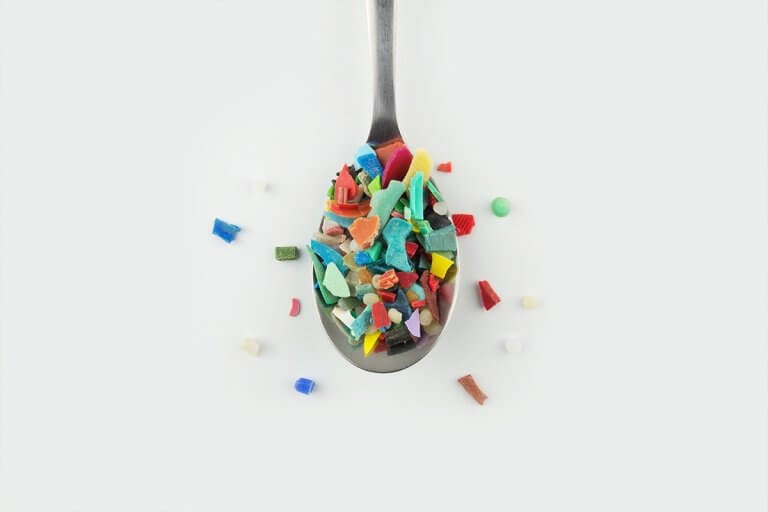

Eco-Anxiety Part 2: When Small Things Add Up – An Overview of The Microplastic Issue
Headlines continuously come out reporting another part of the world that has been infected by microplastics (MPs). It started with the water, the air, and remote locations untouched by humans. This flood of information in addition to catching a shark entangled with plastic during my undergraduate career is what inspired me to focus my research efforts on MPs. During that research, I observed MPs in over 200 liters of coastal water samples, > 3,000 meters of beaches, and even in between the layers of a shark’s stomach. In recent years, these titles have been hitting closer to home: plastics found in breast milk, placentas, our hearts, and our blood. There are even studies looking into the effects of MPs crossing the blood brain barrier in mice. At this point, a really good question is “where aren’t MPs?”
They may be everywhere, but what are they? MPs are a type of plastics classified by their size. Based on the longest dimension, an MP is greater than 1 nanometer and less than 5 millimeters, per The Interstate Technology Regulatory Council. There are two classes of MPs, primary and secondary. Secondary MPs break or shed from primary plastics, such as a plastic bags, shirts, or water bottles. Unlike natural materials, plastics seldom degrade back into the environment. Weathering and time break them into smaller and smaller particles, however some true degradation by fungi and bacteria has recently been identified. Primary MPs, however, are small from the start. Some common examples of primary MPs are the microbeads that were banned from cosmetics and nurdles (aka pre-production pellets). Nurdles are small plastic pellets used to fill molds in product manufacturing. They are useful when transporting products, as you can fit more nurdles into a container than you could the product they will be made into (e.g., water bottles). The main issue with nurdles is that they are easily leaked into the environment and resemble target food items, like frog or fish eggs, that animals will happily consume.
Plastics are pervasive in the environment, our homes, and our bodies. Plastic production rates continue to increase and the current waste systems available are not set up to properly tackle the issue at hand. It is understandable to feel overwhelmed by the news regarding this issue. If you find yourself looking for actionable steps you can take to mitigate the intrusion of MPs into your life, please read on.
Reasons for Hope
Research can only be conducted on issues that we’re aware of. Since MPs are still an emerging topic, so the science itself needs time to grow. A huge step necessary for the efficacy of scientific studies is developing method standards so that studies are comparable. If you cannot compare studies across the field, the possibility of answering questions about this issue starts to crumble.
In 2022, California Water Boards announced the first governmental establishment of standardized methods to monitor MPs in drinking water in the world. Along with the methods, the board required 30 water agencies to begin MP analysis in late 2023. It is likely that these requirements will affect more agencies. The ASTM has also been developing standards for testing with input from members including the US EPA. Needless to say, Environmental Standards has been diligently watching the progression of method development and potential regulation, in preparation to assist our clients.
Being Proactive
The myriad headlines can leave one feeling overwhelmed and full of plastic. And when they’re so small, how can you avoid what you cannot see? While we cannot individually solve this issue, there are steps that we can take to reduce plastics in our lives and the world around us. Once one is aware of the issue, the next step is finding which areas of your life have the highest exposure risk and adjusting from there. Keep in mind that everyone will have different risk levels depending on what they do, where they live, etc., as you read these general tips.
Consumption of Rubbish
If you couldn’t have guessed by now, one of the biggest contributing factors to our daily MP exposure is from consuming them. Unfortunately, many of us take for granted items we use daily due to convenience and ease; however, being more conscientious of our options and choices will always be the first line of combating any environmental pollutant issue. Some simple changes that would reduce direct consumption are as follows:
- Upgrade to stainless steel or silicone water bottles and/or tumblers for hot and cold beverages.
- Use reusable glasses for drinking.
- Filter your water prior to use.
- Avoid microwaving food in plastic Tupperware, takeout boxes, or frozen consumer products like meals and steam in bags.
- Have a ceramic or glass bowl and/or plate set aside for heating up food at the office.
- Switch to silicone, stainless steel, or wooden kitchen utensils (spatulas, spoons, ladles, etc.) instead of using plastic.
- Switch to glass food containers and/or silicone bags for storage of food.
Take a Deep Breath
Food is often the focus when discussing MP intake; however, a major exposure route that is often ignored is the thing we do most – breathing! One review paper that summarized data from three MP-inhalation studies estimates that we breathe approximately 5.9 particles each day (Domenech and Marcos 2021). This area is understudied and highly variable between different locations.
It’s not difficult to recall when the world was clamoring for protective masks in 2020. As that was going on, I was interested to see if donning those barriers would result in more MP inhalation, as a majority of the masks are made from woven plastic. A study by Li et al. (2021) compared MP inhalation rates for various mask types. They reported the following:
- When worn for less than four hours, all mask types generally reduce MP fiber intake.
- Re-wearing masks can increase MP fiber inhalation.
- N95 pose the least MP fiber inhalation from the mask itself as well as particles from the environment.
- If disinfecting masks, ultraviolet (UV) method is the least destructive.
Washing Your Worries Away
- Reduce synthetic textiles in your life by opting for natural fibers (g., cotton, linen, bamboo, etc.)
- These fibers can be pricey, but sifting through a thrift store can be a way to work these into your wardrobe on a budget.
- Fibers can shed into the water during a wash. A 2016 study by Napper and Thompson reported that a single wash load of 13.2 pounds of wash can release an average of 700,000 fibers down the drain.
- There are products like the Cora Ball or the Guppy Friend Bag can help catch MPs before they enter the water. For a more effective but pricier solution, you can install a filter on your washing machine that catches a majority of the fibers as the water drains. You can read this study to see how these products compare.
As standardized methods emerge and accreditation is assigned to laboratories, Environmental Standards will be sure to keep you up to date on MP analysisY
References:
- Breast Milk: https://www.mdpi.com/2073-4360/14/13/2700
- Placentas: https://pubmed.ncbi.nlm.nih.gov/33395930/
- Hearts: https://pubs.acs.org/doi/epdf/10.1021/acs.est.2c07179
- Blood: https://www.sciencedirect.com/science/article/pii/S0160412022001258
- Blood Brain Barrier Studies: https://www.sciencedirect.com/science/article/abs/pii/S0045653522007548
- The Interstate Technology Regulatory Council: https://dtsc.ca.gov/wp-content/uploads/sites/31/2023/06/Safer-Consumer-Products-Microplastics-Workshop-VHanley-Slides-Accessible.pdf
- Microbead Ban: https://www.fda.gov/cosmetics/cosmetics-laws-regulations/microbead-free-waters-act-faqs#:~:text=The%20Microbead%2DFree%20Waters%20Act%20of%202015%20prohibits%20the%20manufacturing,)%20drugs%2C%20such%20as%20toothpastes.
- Plastic waste issues: https://www.ncbi.nlm.nih.gov/pmc/articles/PMC9857911/
- California Water Boards Standards: https://www.waterboards.ca.gov/drinking_water/certlic/drinkingwater/microplastics.html
- Inhalation study: https://www.sciencedirect.com/science/article/pii/S2214799321000084
- Mask Study: https://www.ncbi.nlm.nih.gov/pmc/articles/PMC7773316/
- Microplastics Released in Laundry: https://www.sciencedirect.com/science/article/abs/pii/S0025326X16307639
- Laundry Product Comparison: https://www.sciencedirect.com/science/article/abs/pii/S0048969720339346?via%3Di


